Restaurant: Ishikawa
Address: 〒162-0825 東京都新宿区 神楽坂5−37 高村ビル1F
Date and time of the meal: 18/11/2014 17:30
Type of cuisine: Kaiseki
Phone:03-5225-0173
Tabelog: 4.33/5
Michelin stars: 3
URL: http://www.kagurazaka-ishikawa.co.jp/
Kagurazaka Ishikawa is a well known kaiseki house in the area of Shinjuku (Shinjuku is vast, though, so keep in mind that if you stay close to the Shinjuku JR station, Ishikawa is really NOT in the vicinity….;p). They have been operating for 11 years now. Chef Ishikawa explained that he comes from a part of Japan where the rice is of exceptional quality (yagata?? I am not familiar with Japanese names but it sounded like that), so he plays particular attention to the handling and preparation of the rice (at a place like Ishikawa, you realize that rice is an ingredient that we, in the West,should take seriously as great rice is not … just rice, indeed). The service here is world class (couple of waitresses and some few chefs) and the decor tasteful. I tried to discretely take the pics of my food, discretely I insist as Japanese do not like that sort of distraction, especially in such intimate settings (in some of the restaurants that I will visit later on, photo taking is banned— at Ishikawa they are so nice that they won’t tell you anything, but play close attention at the behavior of the other patrons and you’ll get what I mean ) , so as I usually do, out of respect to the privacy of other diners, I refrained from taking pictures of the room when it was full of patrons.
Kaiseki is my favourite type of Japanese meal for its strong focus on all sorts of seasonal produce. It is also the kind of meal that I do approach with a lot of anxiety (positive / constructive anxiety that is), because I remember that I, too, come from a country with food of deep and extreme nuances/subtleties/complexity , therefore condemned to be mis-interpreted / mis-judged because as diners, we mostly have no time with how things are supposed to be, rather interested to expect things to be what we want them to be . I remember, couple of years ago, inviting a long time food journalist/cook/experienced foodie to eat a dish of cassava leaves cooked in coconut milk. A dish of the kind that I like a lot since its description is ordinary, its execution pertains to a totally different registry. In facts, you need to find the proper cassava leaves, cook it for at least 6-7 hrs with the right amount of quality coconut milk (popular in some African cuisines ) and its final taste will depend on your palate and ability to keep enhancing the flavor with as little as coconut milk, water, garlic, onions, salt , your leaves and deep understanding of how fire can impart sublime taste to your food. I ensured that a long time experienced cook, a granny actually, cooked it, because I wanted that friend to start with a version of that dish cooked by “hands and a palate ” of considerable experience. That friend/foodie/cook’s verdict on that day was straightfoward: it’s bad, it is just leaves that he would have boiled, nothing more and that all the attention to details and long time cooking was pure Bullshit. The granny was upset and accused that dude of ignorance. Both reactions were expected, but I simply asked my friend to try, as much as he could, to remember that supposedly ‘disgusting taste of simple boiled leaves’ but …since he loves food…. to keep his mind open and give a chance to that dish, wherever he finds it. But more importantly, to do it himself and try replicating that exact memory of taste. 10 years later, this is the dish that my friend admires the most, cooks the most, etc. Of course, this sounds like a fairy tale — I know, i know …. we are ALL mostly pessimistic by nature, and tend to be bored with nice stories lol — but there’s a reason I brought the “fairy tale” here: Kaiseki suffers from the same faith…its complexity, its depth, its purpose is not always evident, especially for non Japanese palates/tastes. Even for someone like me who has cooked seriously for almost two decades, and have studied and practiced a lot with the nuances of Japanese fares for the past 3 years (it was important for me to spend some time learning/understanding/practicising with one type of cuisine before starting to assess it) , I had to go out of my way in understanding one important element: the work of the texture and exceptional focus on the details is for the Japanese leading Chefs far more important than how it is valued elsewhere.
The food report:
–Blanched blowfish tossed with Japanese herbs, grated white radish sauce. Basically a julienne of veggies with morsels of blowfish. Tasty, but not a testament to high level kaiseki cooking ( ordinary for a restaurant of this reputation) as it lacked a sign or two of restaurant quality brilliance (anyone could pull out this sort of ordinary flavors , in an effortless way, at a restaurant or at home…therefore, I was not happy with this item ) . 6/10
–Deep fried shitake mushroom with minced Japanese duck,sliced duck breast, dried shitake mushroom: the quality of both the duck and the mushroom was impressive, but there was more. There was technique (the cooking of both the duck and the mushroom superbly achieved in letting the deep meaty flavor of the duck expressing itself, the mushroom timely roasted so that its earthy flavor is left unaltered while the mushroom is cooked enough and nicely seasoned to spectacular mouthfeel ) and an inspired touch (it is easy to extract decent flavors out of duck and mushroom, but harder to get duck and mushroom complementing each other this well. Exciting 10/10
–White miso soup with savory rice cake. The quality of the ingredients continues to be, as I’d expect from a restaurant of this reputation, of the highest order. Such comment also applies to the technical execution of the food: as mastered as it gets ,meaning the balance of flavors is spot on, seasoning judicious (never too salty, never bland). The beauty of great kaiseki cooking is to extract the most out of the least, and that is what they’ve accomplished successfully: deep , balanced, delicious and complex flavors out of a simple rice cake and miso soup. Miso soup is one of those things that escapes attention when done well but which failure you will quickly notice, so it is easy to take such great work of this soup for granted . Excellent Miso soup like this one I was sampling is a rare treat,even in Tokyo, as I came to realise. 9/10
–Sea bream sashimi . I am not too sure what one should expect from seabream. There’s no exceptional seabream flesh, there are just great and bad ones. This was of the great sort. The quality of the seaweed high. As great as ..great fresh seabream flesh tastes.
–Seared Ise Lobster with vinegared soya sauce – quality lobster, one piece served raw (sashimi), the other seared. The quality of an ingredient is always half the battle/ the quality of this lobster was high. There was a true fresh taste of the sea when eating the raw lobster, which was a reminder that no ordinary lobster was served. Then you had the charcoal grilled piece, which did not fail to remind that quality seafood cooked using a flavor-enhancing cooking method like charcoal grilling does ultimately water the mouth. Delicious as one would expect,the soya sauce is,of course, of the non ordinary sort 8/10
–Charcoal grilled horsehead snapper flavored with salted bonito innards sauce is a technique that I will steal from them as I love charcoal-grilling fish at home (using a hibachi charcoal bbq grill) but I was looking for new ways to enhance the natural flavor of charcoal grilled seafood. Bonito innards sauce is exactly what I was looking for: a distracted palate would think that you’ll get the same palatable impact using just salt .Well,no…there is indeed an impression of ‘that is easy to replicate’ when flavoring fish with salted bonito innards sauce, but the level of the complexity of the resulting flavor is not that easy to emulate. This sauce matched beautifully with the snapper. Whether it is street food or fine dining, I do not have unrealistic expectations when it comes to charcoal grill seafood. I just expect an exceptional understanding of what makes a simple piece of fish ..tasting great! Which is what they did. Superb 9/10
–Gluten bread with walnut and dried sea cucumber . The sea cucumber oceanic flavor, striking (in a very very good way). I am usually accused of being very conservative about drying / and or dry-aging seafood, but that is because I find that seafood drying and/or drying aging is often misunderstood (you really need to know which seafood is truly enhanced by such process ). This sea cucumber was timely dried, the exciting mouthfeel and aromas are a testament to its high quality and this is an instance where drying seafood adds — rather than substracting — to the pleasure of eating food. 8/10
–Fresh water eel was flawless in all aspects: top quality eel, the tsume sauce highly enjoyable both in texture and taste, the mashed taro packed with vibrant fresh earthy flavors. As it is the case with all the other offerings, the ingredients are complementary BUT in an inspired/thoughtful/witty way (only the 1st offering tasted and felt like an ordinary assemblage of food items). Flawless. 9/10
–Hot pot of snow crab, tofu and seasonal vegetable. That the ingredients would remain of very high quality was not a surprise anymore, so it’s in the work of the broth that I had high expectations. They were met: the broth had depth/complexity, its taste exciting. A world class hot pot, with a benchmark tofu (I am a huge fan of tofu as it is one of those little things that is easy to overlook but that can marvel when executed masterfully ….the tofu,here, impossibly soft, its taste not bold at all and yet so revealing in subtleties) . 10/10
–Steamed rice, seabream paste and pickled vegetables. I won’t rate this dish as my opinion is sadly..biaised.Biaised because the seabream paste was reminescent of our canned tuna in the western world, therefore I am unable to appreciate that seabream paste as I wished … because I can’t genuinely get excited about flavors and texture of this sort. Needless to stress that there is no fault here (it’s one perfect legit version of a seabream paste), just a clash with a personal perception. What I will do,though,is NOT to overlook the star of this dish, the rice. Again, the Chef seemed to have mentioned Yagata (???) — correct me if I am wrong — as the place of origin of his rice. This, to put it boldly, was spectacular rice with superlative flavor and texture. That he steamed his rice like a master at his craft is not the sole reason behind that incredible bowl of rice (10/10 for that benchmark rice). At some point, they transformed the dish into their take of the ochazuke dish (combination of green tea/steamed rice) which, on this instance, combined the spectacular rice, a perfect broth, nori, the seabream paste and sesame seeds. The overall was tasty.
–Sweet red beans,Yuzu citrus ager and cream cheese with toasted wafer featured quality red beans which sweetness is not overwhelming but judicious, the yuzu citrus ager flawless in texture and adding necessary acidic balance, the cream cheese is a far better version of the standard cream cheese as its soft consistency coupled with superb lactic mouthfeel did stole the show . It is easy to overlook simple ingredients like those (red beans, cream cheese) as they are taken for granted, therefore we tend to be uninvolved when we use them. This dessert was a reminder that doing so (underestimating such humble/common ingredients) is a mistake as cream cheese/red beans/yuzu citrus ager done this well and tasting this good can be exciting. 8/10
Overall food rating: 8/10 (Category: top tier Kaiseki in Tokyo) Kaiseki cuisine (in this case, Chef Ishikawa’s take on it) is very simple in appearance, thefore it can sometimes gives the wrong impression that it is hard to get excited about, but its subtleties can reveal a lot more than what its first impressions may suggest. Ishikawa was about that, and much more: great service , a sense of place, ingredients of the highest quality and more importantly …. a great sense of taste. Ishikawa has an understanding of flavor combination that floats my boat (always that little inspired touch that imparts either surprise or joy in mouth,for eg the rice cake of the miso soup –not the classic texture of rice cake, rather a texture close to marshmallow and it happened to be more effective than the other sorts of rice cakes in its intent to surprise/please. Or a zest of orange skin that tentalized and added a thoughtful kick to the snow crab’s broth. All things that sound easy to do, but you still have to make it happen. Most, in the restaurant industry are NOT doing it. They just talk. But Ishikawa walks the walk and that is why I am impressed by them ). I loved Ishikawa.
What I think weeks later: That rice, that rice …I do not know if their rice is always that stellar, but the one I was having was like no other rice.

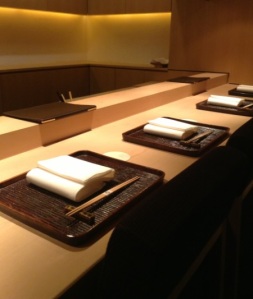
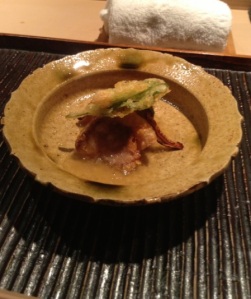
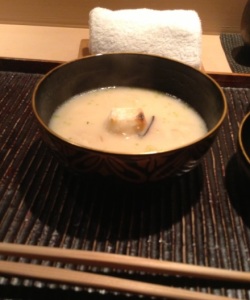
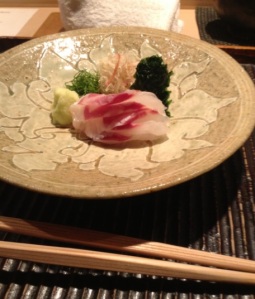
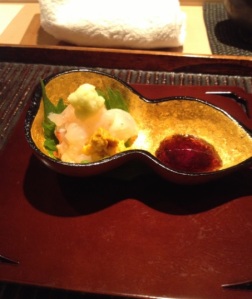
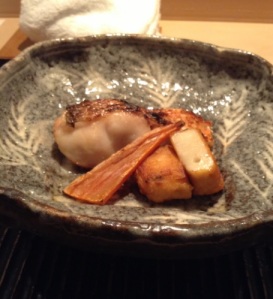
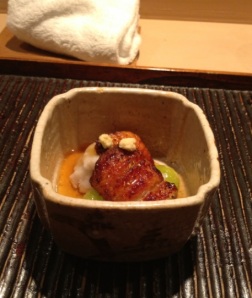
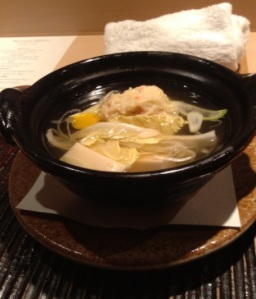
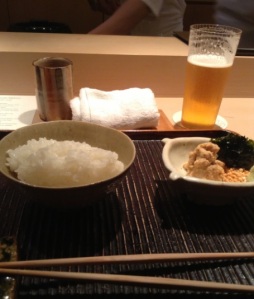
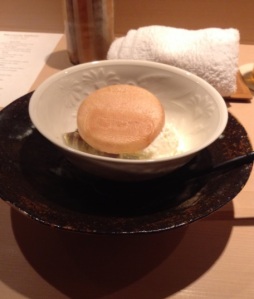
You must be logged in to post a comment.